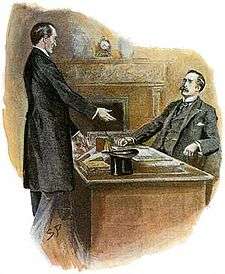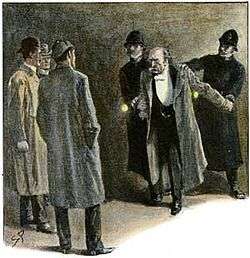The Adventure of the Empty House
| "The Adventure of the Empty House" | |
|---|---|
 1903 illustration by Sidney Paget | |
| Author | Arthur Conan Doyle |
| Series | The Return of Sherlock Holmes |
| Publication date | 1903 |
"The Adventure of the Empty House", one of the 56 Sherlock Holmes short stories written by British author Sir Arthur Conan Doyle, is one of 13 stories in the cycle collected as The Return of Sherlock Holmes.
Public pressure forced Conan Doyle to bring the sleuth back to life, and explain his apparently miraculous survival of a deadly struggle with Professor Moriarty. This is the first Holmes story set after his supposed death at the Reichenbach Falls, as recounted in "The Final Problem". The Hound of the Baskervilles had seen the return of a pre-Reichenbach Falls Sherlock Holmes, which only served to whet readers' appetites.
Doyle ranked "The Adventure of the Empty House" sixth in his list of his twelve favorite Holmes stories.
Plot
The story takes place in 1894, three years after the death of Sherlock Holmes. On the night of March 30, an apparently unsolvable locked-room murder takes place in London: the Park Lane Mystery, the killing of the Honourable Ronald Adair, son of the Earl of Maynooth, a colonial governor in Australia. He was in his sitting room, working on accounts of some kind, as indicated by the papers and money found by police. Adair liked playing whist and regularly did so at several clubs, but never for great sums of money. It does, however, come out that he won as much as £420 in partnership with Colonel Sebastian Moran. The motive does not appear to be robbery as nothing has been stolen, and it seems that Adair had not an enemy in the world. It seems odd that Ronald's door was locked from the inside. The only other way out was the open window, and there was a 20-foot (about 6 m) drop below it onto a flower bed, which now shows no sign of being disturbed. Adair was killed with a soft-nosed revolver bullet to the head. No one in the area at the time heard a shot.

In April, Doctor Watson (now a widower), having retained an interest in crime from his previous association with Holmes, visits the crime scene at 427 Park Lane. He sees a plainclothes detective there with police, and also runs into an elderly deformed book collector, knocking several of his books to the ground. The encounter ends with the man snarling in anger and going away. However, that is not the last that Watson sees of him, for a short time later, the man comes to Watson's study in Kensington to apologize for his earlier behaviour. Once he manages to distract Watson's attention for a few seconds (making Watson turn his head), he transforms himself into Sherlock Holmes, much to Watson's great astonishment when he turns back round.
Contrary to what Watson believed, Holmes won against Professor Moriarty at Reichenbach Falls, flinging him down the waterfall with the help of baritsu, and then he climbed up the cliff beside the path to make it appear as though he, too, had fallen to his death. This was a plan that Holmes had just conceived to defend against Moriarty's confederates. However, at least one of them knew that he was still alive and tried to kill him by dropping rocks down on the ledge where he had taken refuge. Hurriedly climbing back down the cliff — and falling the last short distance to the path — Holmes ran for his life and, by the next week, he was in Florence. Holmes apologizes to Watson for the deception needed to outwit his enemies, and describes his three years' exploits, explaining that he spent the next few years traveling to various parts of the world. First, he went to Tibet and wandered for two years, even attaining entry to Lhasa and met the "head lama". Afterward, Holmes travelled incognito as a Norwegian explorer named Sigerson. Then, he went to Persia, with Holmes entering Mecca and then to a brief stopover with the Khalifa in Khartoum. Finally, before returning, Holmes spent time doing chemical research on coal tar derivatives in Montpellier, France. However, Holmes was finally brought back to London by the news of Adair's murder. During all this time, the only people who knew that Holmes was alive were Moriarty's henchmen and Holmes's brother Mycroft, who provided him with the money he needed.
Holmes tells Watson that they are going to do some dangerous work that evening, and after a roundabout trip through the city, they enter an empty house, an abandoned building known as Camden House whose front room overlooks — to Watson's great surprise — Baker Street. Holmes's room can be seen across the street, and more surprisingly still, Holmes can be seen silhouetted against the blind: it is a lifelike waxwork bust, moved regularly from below by Mrs. Hudson to simulate life. Holmes employs the dummy because he was seen by one of Moriarty's men, and thus he expects an attempt on his life that very night. After a roundabout route, Watson and Holmes wait two hours until around midnight in the abandoned Camden House. A sniper, who has taken the bait, fires a specialized air-rifle to assassinate his foe. Surprisingly, he chooses Camden House as his vantage point.

Once the ruffian shoots his air-rifle, scoring a direct hit on Holmes's dummy across the street, Holmes and Watson are on him, and he is soon disarmed and restrained. While Watson knocks down the enemy, Holmes summons the police by blowing a whistle. They are led by Inspector Lestrade, who arrests the gunman. It is none other than Colonel Moran, Ronald Adair's whist partner, and the same man who threw rocks down on the ledge at Holmes at Reichenbach Falls. Holmes does not wish the police to press charges of attempted murder in connection with what Moran has just done. Instead, he tells Lestrade to charge him with actual murder, for Moran is the man who murdered Ronald Adair. The air-rifle, it turns out, has been specially designed to shoot revolver bullets, and a quick forensics check of the one that "killed" his dummy shows, as Holmes expected, that it matches the bullet used to kill Adair.
Holmes and Watson then go to their old apartment in Baker Street, where Holmes' rooms were kept as he had left them thanks to Mycroft's supervision. Moran's motive in killing Adair is a matter of speculation even for Holmes. Nonetheless, his theory is that Adair had caught Moran cheating at cards, and threatened to expose his dishonourable behaviour. Moran therefore got rid of the one man who could rob him of his livelihood, for he earned a living playing cards crookedly, and could ill afford to be barred from all his clubs.
Adaptations
This story was filmed in 1921 as part of a series of silent films starring Eille Norwood as Holmes.[1]
The story, along with "The Disappearance of Lady Frances Carfax", "The Adventure of Charles Augustus Milverton", and "The Red-Headed League", provided the source material for the 1923 play The Return of Sherlock Holmes.
The 1931 film The Sleeping Cardinal (also known as Sherlock Holmes' Fatal Hour) is loosely based on "The Adventure of the Empty House" and "The Final Problem".
Many Elements of "The Adventure of the Empty House" were used in the 1939–1946 Sherlock Holmes series starring Basil Rathbone and Nigel Bruce. In Sherlock Holmes and the Secret Weapon (1943), Holmes a disguises himself as a German bookseller in Switzerland. The Woman in Green (1945) uses the scene in which a sniper attempts to shoot Holmes from across the street and shoots a wax bust instead, and he is apprehended by Holmes and Watson who lie in wait. Colonel Sebastian Moran appears as the villain in Terror by Night (1946) as the last of Moriarty's gang.
The story was adapted for a 1951 TV episode of Sherlock Holmes starring Alan Wheatley as Holmes but the episode is now lost. [2]
The story was adapted in 1980 as an episode of the Soviet TV series The Adventures of Sherlock Holmes and Dr. Watson starring Vasily Livanov. The episode is very close to the source, as was typical of the entire series, with some minor departures: Adair is still alive at the start of the episode, Watson unsuccessfully tries to protect him as instructed by Holmes, Watson briefly becomes a prime suspect in Adair's murder, Watson and Mrs. Hudson faint when the presumed deceased Holmes appears at Baker Street, and both Holmes and Moriarty are made masters of the martial art baritsu, with a dramatic battle between the two.
The story was later adapted in 1986 as an episode of The Return of Sherlock Holmes starring Jeremy Brett. The episode is rather faithful to Doyle's story, except that Moran tries to shoot Holmes in Switzerland instead of dropping boulders on him, and it is Watson – not Holmes – that deduces the reason that Moran had for killing Ronald Adair. It was the first episode to feature Edward Hardwicke as Dr Watson, replacing David Burke who had played the role in the preceding episodes (Hardwicke reenacted a scene from The Final Problem in a flashback, consisting of Watson at the waterfall shouting to Holmes and reading his letter, which had been performed by Burke).
(In the BBC Radio adaptation of "The Empty Room" starring Carlton Hobbs as Sherlock Holmes and Norman Shelley as Doctor Watson, Shelley refers to Ronald Adair as "Rupert" Adair, only to be corrected by Hobbs. It is a debate among Sherlock Holmes aficionados whether this was a mistake or an intentional humorous part of the script!)
"The Empty House" was dramatised for BBC Radio 4 in 1993 by Bert Coules as part of his complete radio adaptation of the canon, starring Clive Merrison as Holmes and Michael Williams as Watson, and featuring Michael Pennington as Professor Moriarty, Frederick Treves as Colonel Moran, Donald Gee as Inspector Lestrade, and Peter Penry-Jones as Sir John.[3]
The 2009 radio play The Return of Sherlock Holmes, dramatised by M.J. Elliott combines "The Empty House" and "The Final Problem".
In the final scene in the 2011 film Sherlock Holmes: A Game of Shadows, it is revealed that Holmes survives his encounter with Professor Moriarty (the film is influenced by "The Final Problem"). Colonel Moran appears as Moriarty's main henchman in the film and is portrayed as a skilled marksman who uses a number of different ranged weapons to kill his master's targets.
In 1975, DC Comics published Sherlock Holmes #1, a comic which adapted "The Adventure of the Empty House" and "The Final Problem".[4] It was intended to be an ongoing series, but future issues were cancelled due to low sales.
Harry Paget Flashman witnesses the events of this story in the novel Flashman and the Tiger by George MacDonald Fraser.
References
- ↑ The Empty House (1921)
- ↑ IMDb – "Sherlock Holmes" The Empty House (TV episode 1951)
- ↑ Bert Coules. "The Return of Sherlock Holmes". The BBC complete audio Sherlock Holmes. Retrieved 12 December 2016.
- ↑ "A Study in Sherlock" DC Comics: Sherlock Holmes #1
External links

